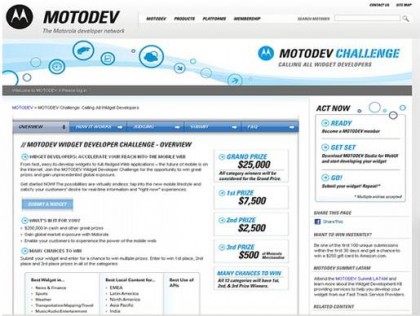
I’m a big fan of widgets – online, on TV, and on random gadgets that happen to be connected to the Internet – which is why news of a Widget Developer Challenge out of Motorola this week piqued my interest. (Keep in mind, I’m employed by Motorola, so take that as you will. But also know that I don’t work for the Mobile Devices business.)
Motorola is accepting widget entries for its Challenge in three basic areas: Best Widget in a Category (sports, weather, shopping, etc.), Best Local Content (based on geographic region), and Best Use of APIs. There’s also a grand prize being awarded for Best Overall Widget. Anyone can enter, and top prize gets $25,000.
Widgets submitted for the contest will be designed to operate on Motorola phones “equipped with a widgets framework.” The first of these phones is the new MOTO VE66, and Motorola promises more to come. But what’s really interesting here is something the folks over at AndroidGuys pointed out:
Typically, widgets operate the same, regardless of the operating system, so these entries should work on future Motorola phones based on Android, including the rumored “social networking” phone. Written in web standards like xhtml and css widgets can place frequently updated information directly onto a phone’s background, adding new content and features without firmware updates.
Want to do a little app dev for a future Android phone? This might be your chance. My single, solitary programming class in college puts me out of the running (not to mention the whole employer thing), but I’m happy to enjoy the widgety fruits of someone else’s labor.
Screenshots below of sample Motorola widgets provided by the MOTODEV team. They also have a Twitter stream.
“…Want to do a little app dev for a future Android phone?”
If Moto would OFFICIALLY state they are going to release an Android phone to the Consumer, available through the Moto store, unlocked, and not carrier neutral – Then “yes” I would.
I cheer that Moto is having a widget contest, by a suggestion would be:
If you want the same developer usage and adoption you see Apple’s iPhone and T-Mobile’s G1, you need to not operate in secret, keep us all guessing about mythical handsets that don’t actually exist. Or worse, I develop a cool widget, only to see it high jacked or banned ( ala what Apple did to Podcaster ).
@Todd All completely valid points. But worst case, you get a chance to win $25k.
I’d love to see some widgets in the ITV platforms for Motorola set top boxes. I know Verizon has been on the forefront of innovation on set top software, but maybe if more people could develop set top applications in OCAP, more MSO’s would be inspired to add features and functionality to their on screen interfaces.
With OCAP and Java TV API’s, the development platform should be more open. The middleware can be closed source so fear of ‘hackers’ breaking down to lower levels to corrupt boxes to do bad things should be minimized. With just a java sandbox UI layer, I think development should be opened up, much like it is for mobile devices.
cypherstream, Ive thought the same thing for the last 2+ years, but I havent heard of *1* company letting it happen.